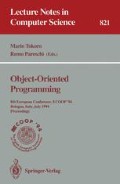Abstract
One can observe the following parallel developments: an increasing merge of computer, network and telecommunication technology, new needs and markets in the information and media industry, indications of changes in the way people use information in their work and in their home environments. A common factor is the digitalization of information at the time it is processed or — resulting in more possibilities — when it is created. But the progress in networks and basic technology is not paralleled to the same degree by advances in the development of corresponding applications which — in the end — are necessary to justify the immense investments, e.g. in information super highways. One important class of applications is support for the cooperation of spatially distributed people working with shared information objects. We propose that “hypermedia” serve not only as the “subject matter” of cooperation but also as a “medium” for coordination, communication, and cooperation by using specific object types and exploiting their properties. In order to provide examples of how hypermedia can support telecooperation, we will present the design and implementation of two group aware applications — SEPIA and DOLPHIN — which were developed at GMD-IPSI.
Preview
Unable to display preview. Download preview PDF.
References
J. Conklin (1987). Hypertext: An introduction and survey. Computer, 20, 17–41.
C. Ellis, J Gibbs, G. Rein, (1991). Groupware — some issues and experiences. Communications of the ACM, Vol. 34 No.1 (January 1991), 38–58.
S. Elrod, et al. (1992). Liveboard: a large interactive display supporting group meetings, presentations and remote collaboration. Proceedings of the CHI'92 Conference, Monterey, CA, USA (May 3–7, 1992), 599–607.
J. Haake & B. Wilson (1992). Supporting Collaborative Writing of Hyperdocuments in SEPIA. In Proceedings of the ACM 1992 Conference on Computer-Supported Cooperative Work (CSCW'92) (pp. 138–146) Toronto, Ontario, November 1–4, 1992. New York: ACM Press.
J. Haake, C. Neuwirth, & N. Streitz (1994). Coexistence and Transformations of Informal and Formal Structures: Requirements for More Flexible Hypermedia Systems. GMD-IPSI Technical Report, April 1994.
F. Halasz (1988). Reflections on Notecards: Seven issues for the next generation of hypermedia systems. Communications of the ACM, 31, 7, 836–852.
F. Halasz (1991). “Seven issues”: Revisited. Final Keynote Talk at the 3rd ACM Conference on Hypertext, San Antonio, TX, December 15–18, 1991.
C. Marshall & A. Rogers (1992). Two years before the mist: Experiences with Aquanet. Proceedings of the ACM European Conference on Hypertext (ECHT'92), Milano, Italy, Nov. 30–Dec. 4, 1992, 53–62.
T. Nelson (1987). Literary machines. Edition 87.1
H. Schütt & J. Haake (1993). Server Support for Cooperative Hypermedia Environments. In H. Frei & P. SchÄuble (eds.), Hypermedia'93. (pp. 45–56) Springer.
H. Schütt & N. Streitz (1990). HyperBase: A Hypermedia Engine Based on a Relational Database Management System. In A. Rizk, N. Streitz, & J. André (eds.), Hypertext: Concepts, Systems, and Applications (ECHT'90) (pp. 95–108). Cambridge: Cambridge University Press.
N. Streitz, J. Hannemann & M. Thüring (1989). From Ideas and Arguments to Hyperdocuments: Travelling through Activity Spaces. In Proceedings of the 2nd ACM Conference on Hypertext (Hypertext'89) (pp. 343–364). ACM Press.
N. Streitz, J. Haake, J. Hannemann, A. Lemke, W. Schuler, H. Schütt & M. Thüring (1992). SEPIA: A Cooperative Hypermedia Authoring Environment. In Proceedings of the fourth International ACM Conference on Hypertext (ECHT '92) (pp. 11–22) Milano, Italy, November 30–December 4, 1992. ACM Press.
N. Streitz, J. Gei\ler, J. Haake, & J. Hol (1994). DOLPHIN: Integrated Meeting Support across Liveboards, Local and Remote Desktop Environments. Technical Report (Arbeitspapiere der GMD) No. 828, February 1994.
Author information
Authors and Affiliations
Editor information
Rights and permissions
Copyright information
© 1994 Springer-Verlag Berlin Heidelberg
About this paper
Cite this paper
Streitz, N.A. (1994). Putting objects to work: Hypermedia as the subject matter and the medium for computer-supported cooperative work. In: Tokoro, M., Pareschi, R. (eds) Object-Oriented Programming. ECOOP 1994. Lecture Notes in Computer Science, vol 821. Springer, Berlin, Heidelberg. https://doi.org/10.1007/BFb0052183
Download citation
DOI: https://doi.org/10.1007/BFb0052183
Published:
Publisher Name: Springer, Berlin, Heidelberg
Print ISBN: 978-3-540-58202-1
Online ISBN: 978-3-540-48567-4
eBook Packages: Springer Book Archive

